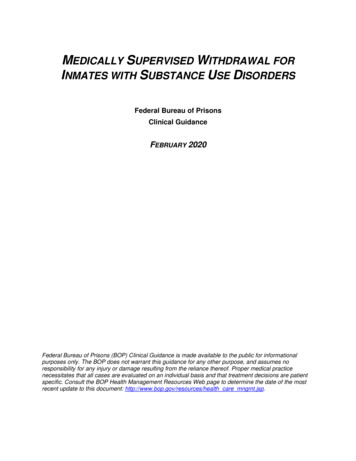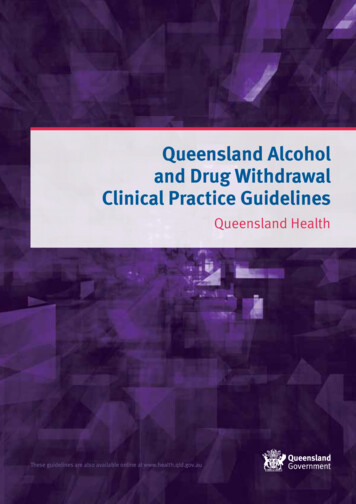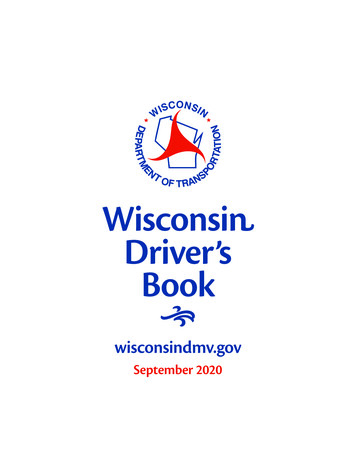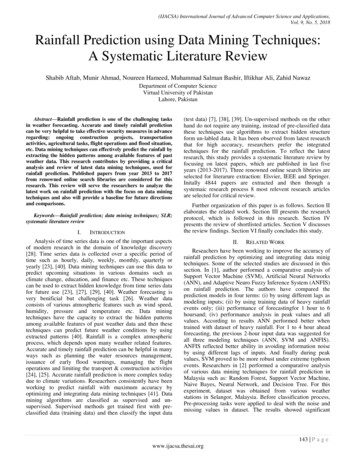
Transcription
MEDICALLY SUPERVISED WITHDRAWAL FORINMATES WITH SUBSTANCE USE DISORDERSFederal Bureau of PrisonsClinical GuidanceFEBRUARY 2020Federal Bureau of Prisons (BOP) Clinical Guidance is made available to the public for informationalpurposes only. The BOP does not warrant this guidance for any other purpose, and assumes noresponsibility for any injury or damage resulting from the reliance thereof. Proper medical practicenecessitates that all cases are evaluated on an individual basis and that treatment decisions are patientspecific. Consult the BOP Health Management Resources Web page to determine the date of the mostrecent update to this document: http://www.bop.gov/resources/health care mngmt.jsp.
Federal Bureau of PrisonsClinical GuidanceMedically Supervised WithdrawalFebruary 2020WHAT’S NEW IN THE DOCUMENT?This document was previously issued in 2014 as the BOP Clinical Guidance for Detoxification ofChemically Dependent Inmates.NOTE: The 2014 BOP Clinical Guidance for Detoxification of Chemically Dependent Inmates was revisedfrom a previous version of the guidance to be in line with the Diagnostic and Statistical Manual of MentalDisorders, Fifth Edition (DSM-5) that was released in May 2013. Other information was included, basedon the Quick Guide for Clinicians Based on TIP 45: Detoxification and Substance Abuse Treatment,issued by the Substance Abuse and Mental Health Services Administration (SAMHSA) in 2006.Among the revisions to the 2014 guidance contained in this document are:TERMINOLOGY: The term detoxification has been changed to medically supervised withdrawal to be consistent withcurrent medical terminology and the BOP Clinical Guidance on Medications for Opioid Use Disorder,to be issued in 2020. Changed language throughout document to reflect current terminology (e.g., abuse changed tomisuse).OPIOID WITHDRAWAL: Information has been revised regarding the use of buprenorphine in the treatment of opioid withdrawalin the BOP, including legal requirements for prescribing and a suggested tapering schedule. Amended management of opioid withdrawal to include considerations for maintenance therapy. In the case of opioid use disorders, TREATMENT OF WITHDRAWAL (the subject of this clinical guidance)should NOT be confused with the TREATMENT OF SUBSTANCE USE DISORDERS, sometimes referred to asMedications for Opioid Use Disorders (MOUD). Treatment of withdrawal is a short-term procedure bywhich medications are used to ease the symptoms of withdrawal, whereas medication treatment foropioid use disorders is a maintenance treatment usually over a longer period of time.ALCOHOL WITHDRAWAL: Removed carbamazepine for alternative management of alcohol withdrawal. Added gabapentin for alternative management of alcohol withdrawal. Updated CIWA-Ar scoring classification to reflect current guidance. See Table 3 and Table 4, as wellas the Total CIWA-AR Score on the Flowsheet in Appendix 2.OTHER: Removed excerpts from the DSM, due to copyright restrictions. Appendix 1, Detoxification Overview, was revised and moved to the new Section 6, Overview ofWithdrawal Management. As a result, the main Sections and Appendices have been renumbered. Appendix 1, Symptoms and Signs of Intoxication and Withdrawal, was revised to include alcohol. Additional revisions were made to improve clarity and readability of this document.i
Federal Bureau of PrisonsClinical GuidanceMedically Supervised WithdrawalFebruary 2020TABLE OF CONTENTS1. PURPOSE . 12. INTRODUCTION . 13. GENERAL CONSIDERATIONS IN TREATING WITHDRAWAL . 1TABLE 1. Symptoms and Signs of Withdrawal Requiring Immediate Medical Attention . 34. M ANAGEMENT OF INMATES WITH COMPLICATING MEDICAL AND PSYCHIATRIC CONDITIONS . 45. PLACEMENT OF INMATES FOR TREATMENT OF WITHDRAWAL . 56. OVERVIEW OF WITHDRAWAL M ANAGEMENT. 6TABLE 2. Overview of Withdrawal Management . 67. ALCOHOL WITHDRAWAL . 7TABLE 3. Overview of Treatment of Alcohol Withdrawal, Based on CIWA-Ar score . 9TABLE 4. Recommended Schedule for Lorazepam Treatment of Alcohol Withdrawal . 108. BENZODIAZEPINE WITHDRAWAL . 13TABLE 5. Potential Progression of Untreated Benzodiazepine Withdrawal Symptoms . 149. BARBITURATE WITHDRAWAL . 16TABLE 6. Symptoms of Barbiturate Withdrawal . 1710. OPIOID WITHDRAWAL . 1811. COCAINE/STIMULANTS . 2212. INHALANTS . 22DEFINITIONS. 23REFERENCES . 25APPENDIX 1. SYMPTOMS AND SIGNS OF INTOXICATION AND WITHDRAWAL. 27APPENDIX 2. ALCOHOL WITHDRAWAL ASSESSMENT AND TREATMENT FLOWSHEET . 29APPENDIX 3. BENZODIAZEPINE DOSE EQUIVALENTS . 31APPENDIX 4. BARBITURATE DOSE EQUIVALENTS . 32APPENDIX 5. PATIENT INFORMATION – ALCOHOL WITHDRAWAL . 33APPENDIX 6. PATIENT INFORMATION – BENZODIAZEPINE WITHDRAWAL . 34APPENDIX 7. PATIENT INFORMATION – BARBITURATE WITHDRAWAL . 35APPENDIX 8. PATIENT INFORMATION – OPIOID (NARCOTICS) WITHDRAWAL . 36ii
Federal Bureau of PrisonsClinical GuidanceMedically Supervised WithdrawalFebruary 20201. PURPOSEThe Federal Bureau of Prisons (BOP) Clinical Guidance for Medically Supervised Withdrawal forInmates with Substance Use Disorders provides recommended standards for the medicalmanagement of withdrawal for federal inmates with substance use disorders. In the case of opioid use disorders, TREATMENT OF WITHDRAWAL (the subject of this clinical guidance)should NOT be confused with the TREATMENT OF SUBSTANCE USE DISORDERS, sometimes referred to asMedications for Opioid Use Disorders (MOUD). Treatment of withdrawal is a short-term procedure bywhich medications are used to ease the symptoms of withdrawal, whereas medication treatment foropioid use disorders is a maintenance treatment usually over a longer period of time. For information on medication treatment for opioid use disorder, see the BOP Clinical Guidance onMedications for Opioid Use Disorder.2. INTRODUCTIONSubstance misuseaffects not only the individuals who misuse substances and their families, but also society as awhole. Substance misuse is associated with increases in crime, domestic violence, highwayfatalities, incarceration, and health care costs.Substance use disorders (SUDs) pose a significant public health problem.Any substance that alters perception, mood, or cognition can be misused. Commonly misusedsubstances include illicit drugs, alcohol, and certain prescription drugs—which act through theirhallucinogenic, stimulant, sedative, hypnotic, anxiolytic, or narcotic effects. Other lesscommonly misused substances include medications with anticholinergic, antihistaminic, orstimulant effects, e.g., tricyclic antidepressants, antiparkinsonian agents, low potencyantipsychotics, anti-emetics, and cold and allergy preparations.and, while difficult toaccurately measure, some studies have shown that up to 65% of incarcerated persons may havean active SUD.Substance use disorders are highly prevalent among inmate populationsTherecommendations in this guidance reflect expert opinion or consensus and generally acceptedstandards of care.The evidence basis for specific evaluation and treatment recommendations is limited.3. GENERAL CONSIDERATIONS IN TREATING WITHDRAWAL The safe and effective treatment of withdrawal syndromes requires that clinicians be alert tothe possibility of SUDs, physiological dependence, and the risk of withdrawal in all new inmatearrivals at their institutions. Criteria for the diagnosis of SUDs is published in the Diagnostic and Statistical Manual of MentalDisorders, fifth edition (DSM-5).1
Federal Bureau of PrisonsClinical GuidanceMedically Supervised WithdrawalFebruary 2020 A careful inmate history and clinical assessment is essential.Individuals who misuse substances are rarely accurate in their description of patterns of drug use;they can greatly underestimate or deny their misuse of substances, as well as overstate the extentof their misuse. The clinical presentations of intoxication and withdrawal for the different groups of substances arelisted in Appendix 1, Symptoms and Signs of Intoxication and Withdrawal. The use of more than one substance must be carefully considered.Individuals who misuse substances are likely to be misusing multiple substances. Intoxicationfrom or dependence on multiple drugs requires careful attention to withdrawal symptoms andmay complicate treatment of the withdrawal syndrome. The intensity of withdrawal cannot always be predicted. Frequent clinical assessments, alongwith indicated treatment adjustments (in both dose and frequency) are imperative.The addictive nature of a substance is determined by many factors including the physiology,psychology, and neurochemistry of the individual, as well as characteristics of the substanceitself. Generally, the most addictive substances are those that are high-potency, that cross theblood-brain barrier quickly, that have a short half-life, and that produce a significant change inthe neurochemistry of the brain. Substances that produce dangerous and potentially life-threatening withdrawal syndromes forindividuals with physiological dependence include alcohol, sedative/hypnotics, and anxiolytics.Although opioid withdrawal rarely causes death directly, it can occur indirectly from suicidalityor overdose. Opioid withdrawal results in significant symptomatology, which can be markedlyreduced with targeted therapies or prevented with continuation or initiation of medications foropioid use disorder (MOUD). In general, fetal and neonatal outcomes of infants born to mothersin withdrawal are not well-studied, although fetal alcohol syndrome and neonatal abstinencesyndrome are well-described. For more information on withdrawal from opioids see the BOP Clinical Guidance on Medications forOpioid Use Disorders (MOUD). Not all substances that are misused produce clinically significant withdrawal syndromes.However, discontinuing substances on which an individual is dependent will likely producesome PSYCHOLOGICAL SYMPTOMS. Withdrawal from substances such as STIMULANTS, COCAINE,HALLUCINOGENS, and INHALANTS can be accomplished with psychological support and symptomatictreatment alone, along with periodic reassessment by a health care provider. Initiation of withdrawal should be individualized.Substance use disorder often leads to significant medical sequelae including liver disease,chronic infections, trauma, cognitive impairment, psychiatric disorders, nutritional deficiencies,and cardiac disease. Withdrawal is stressful, and may exacerbate or precipitate medical orpsychological decompensation. In some cases, it may be necessary to medically stabilize theindividual and resolve the immediate crisis, prior to initiating withdrawal. Every effort should be made to ameliorate the inmate’s symptoms and signs of withdrawal.Adequate doses of medication should be used, with frequent reassessment. Inmatesexperiencing withdrawal should also be kept as physically active as medically permissible.2
Federal Bureau of PrisonsClinical GuidanceMedically Supervised WithdrawalFebruary 2020 A safe withdrawal plan entails, when feasible, substituting a long-acting, cross-tolerantsubstance. That substance is then gradually tapered according to a schedule dependent uponprior dosing, duration of use, and the setting. As such, some taper-off schedules could lastdays to several months. To the greatest extent possible during withdrawal treatment, the provider should control theinmate’s access to the prescribed medication regimen. Overdose with either the prescribedmedication or other drugs is always a possibility. All medications prescribed for the treatmentof withdrawal should be administered via directly observed therapy. Ideally, dosing should bethree times a day or less, so as to accommodate pill lines at most institutions. Inmates should be counseled on the dangers of supplementing their regimens with over-thecounter medications, prescription medications diverted from other inmates, or illicit drugs andalcohol. Conditions that require immediate medical attention are listed in T ABLE 1 below.TABLE 1. SYMPTOMS AND SIGNS OF WITHDRAWAL REQUIRING IMMEDIATE MEDICAL ATTENTION Change in mental statusIncreasing anxietyHallucinationsTemperature greater than 100.4oF(these patients should be consideredpotentially infectious) Significant increases and/or decreasesin blood pressure and heart rateInsomniaSevere Abdominal painUpper and lower gastrointestinal bleedingChanges in responsiveness of pupilsHeightened deep tendon reflexes and ankleclonus, a reflex beating of the foot whenpressed rostrally, indicating profoundcentral nervous system irritability and thepotential for seizures Medical treatment of withdrawal alone is rarely adequate for the treatment of SUDs. INMATE EDUCATION regarding the withdrawal process is a necessary component of a successfultreatment plan. Clinicians should conduct PERIODIC ASSESSMENTS to detect the development of any psychiatricsymptoms such as depression, suicidal thinking, or underlying psychosis. A REFERRAL TO PSYCHOLOGY SERVICES for an evaluation of drug treatment needs and ongoingpsychological support services is recommended. These services provide alternative methodsof coping with the stresses that trigger alcohol or drug misuse. Psychology staff can alsodetermine whether referrals to drug education or to nonresidential or residential drugtreatment programs are indicated.3
Federal Bureau of PrisonsClinical GuidanceMedically Supervised WithdrawalFebruary 20204. MANAGEMENT OF INMATES WITH COMPLICATING MEDICAL ANDPSYCHIATRIC CONDITIONSCareful consideration should be given to inmates with co-morbid medical and psychiatricconditions, since these patients are at greater risk for severe withdrawal symptoms andcomplications. BRAIN INJURY: Inmates with a history of any brain injury are more likely to suffer seizuresand/or delirium during withdrawal, and therefore require closer monitoring. CO-MORBID SEIZURE DISORDER: The presence of an underlying seizure disorder must beconsidered when managing withdrawal from benzodiazepines, barbiturates, and alcohol.Patients with pre-existing seizure disorders will be more susceptible to seizures as theirmedications are withdrawn; and a slower taper may be indicated for these inmates. CARDIAC DISEASE: Inmates with cardiac disease are more sensitive to sympathetichyperactivity. Careful monitoring and control of symptoms is essential, and a slow taper maybe indicated. LIVER AND KIDNEY DISEASES: Inmates with liver or renal disease may metabolize drugs andmedications more slowly; as such, they require closer monitoring for drug toxicity andpossible adjustments as withdrawal is managed. PSYCHIATRIC DISORDERS: Inmates with pre-existing psychiatric conditions may suffer anexacerbation of their illness during withdrawal. A collaborative treatment effort withpsychology and psychiatry staff is warranted for management of these inmates. Inmateswithout pre-existing psychiatric illness may also experience significant psychological distress,including the development of suicidal ideation, plan, and intent. A careful assessment of theinmate’s mental status, with particular attention to thoughts of self-harm, should be part ofevery evaluation. ELDERLY INMATES: Elderly inmates are at increased risk of complications during withdrawal.The elderly are less likely to show marked sympathetic hyperactivity during withdrawal, butthey are just as likely to suffer a severe withdrawal syndrome. Withdrawal in the elderly isfurther complicated by a greater use of prescription drugs and, therefore, the potential fordrug-drug interactions. Because of a higher incidence of complicating medical conditionssuch as heart disease and cognitive disorders, careful monitoring, ongoing titration ofmedications, and even inpatient hospitalization for complicated patients are often necessary.Because of a greater risk of drug toxicity in the elderly due to slower drug metabolism, ifwithdrawal is managed with a medication taper, it may be necessary to use short-actingmedications. PREGNANCY AND LACTATION: Pregnancy significantly complicates treatment of withdrawal.Many medications cross the placenta and/or are secreted in breast milk. Careful considerationmust be given to the effects of medications on the fetus or infant, and these must be weighedagainst the risks of withdrawal. In most cases, pregnant women should be maintained on theirmedication for SUD throughout their pregnancy, unless contraindicated. Each case is unique,however, and should be managed in close consultation with an obstetrical specialist. Becausethere may be an increased risk of preterm delivery, low infant birth weight, and othermorbidities, the benefits of MOUD during pregnancy are believed to outweigh the risks.4
Federal Bureau of PrisonsClinical GuidanceMedically Supervised WithdrawalFebruary 2020Continuation of MOUD during pregnancy is generally recommended if clinically appropriateand there are no contraindications. Pregnant women with alcohol dependence should bemanaged in an inpatient setting, due to the risk of miscarriage during withdrawal. For more information on MOUD during pregnancy, see the BOP Clinical Guidance on Medicationsfor Opioid Use Disorders. RISK OF SUICIDE: The frequency of suicide attempts is substantially higher among patients witha substance use disorder, even for those without a pre-existing psychiatric condition. Frequentand thorough patient assessments are indicated during the withdrawal period, with particularattention to thoughts of self-harm. SHORT-STAY INMATES: In general, inmates with short sentences, or with lengths of stay thirtydays or less, should NOT be tapered off benzodiazepines or barbiturates if these agents arecurrently medically indicated. If discontinuation of opioids is clinically indicated, treatment ofwithdrawal can be completed safely in less than two weeks. Treatment of withdrawal fromalcohol is necessary for all inmates who present with alcohol use disorder or withdrawal.5. PLACEMENT OF INMATES FOR TREATMENT OF WITHDRAWALTreatment of withdrawal can be safely and effectively accomplished for inmates in a variety ofhousing placements, including: locked jail units, general population, observation cells in thehealth services unit, Special Housing Units, and as inpatients in a community hospital or MedicalReferral Center (MRC). The specific housing placement should be in the least restrictive setting necessary, asdetermined on a case-by-case basis, in accordance with BOP policy and throughmultidisciplinary recommendations made by health care, psychology, and custody staff. Theoptimal placement will depend on the type of substance, the severity of the withdrawalsyndrome, the inmate’s co-morbid medical and psychiatric conditions, security concerns, andthe resources of the institution. If an inmate is placed in a locked unit or Special Housing Unit for treatment of withdrawal, theirmedications, medical assessments, and ongoing monitoring must all be provided in a timelymanner. If treatment in a locked unit or Special Housing Unit cannot be accomplished withthese assurances, strong consideration should be given to one of two options: (1) inpatientplacement or (2) medical stabilization and maintenance, with postponement of attempts fortreatment of withdrawal. Transferring patients from mainline facilities to MRCs for the management of withdrawal isNOT typically indicated or necessary.5
Federal Bureau of PrisonsClinical GuidanceMedically Supervised WithdrawalFebruary 20206. OVERVIEW OF WITHDRAWAL MANAGEMENTManagement of withdrawal, including treatment and monitoring, is specific to the substancebeing misused. TABLE 2 below provides an overview for the most commonly misused substances,including links to more detailed information. This document is for guidance only. Prescribing practitioners must be familiar with official FDAlabeling of any medication they prescribe.TABLE 2. OVERVIEW OF WITHDRAWAL M ANAGEMENTSUBSTANCEMONITORING(section in thisguidance)ALCOHOL(Section 7)CIWA-Ar Score:As frequently asevery hourPRIMARYTREATMENT Lorazepam ThiamineSee Appendix 2.HOSPITALIZATION?Strongly recommended for thefollowing: CIWA-Ar score 20 Wernicke encephalopathy and/orKorsakoff psychosis Current or prior history of deliriumtremens or alcohol-induced seizures PregnancyConsider hospitalization for patientswith CIWA-Ar scores 16–20, significantmalnutrition, or comorbidities.BENZODIAZEPINES(Section 8)BARBITURATES(Section 9)OPIOIDS(Section 10)COCAINE(Section 11)Vital Signs:Three times a dayfor 3 days ClonazepamAs needed for patients showing signsof late (severe) withdrawal, including: Delirium with hallucinations Changes in consciousness Profound agitation Autonomic instability SeizuresVital Signs:Three times a dayfor 3 days PhenobarbitalAs needed for patients showing signsof severe withdrawal, including: Changes in consciousness Profound agitation Hallucinations Autonomic instability SeizuresVital Signs:Daily; more oftenif clonidine used Buprenorphine Methadone SymptomaticUsually not necessaryVital Signs:As needed SymptomaticUsually not necessary6
Federal Bureau of PrisonsClinical GuidanceMedically Supervised WithdrawalFebruary 20207. ALCOHOL WITHDRAWAL All incoming inmates should be screened for a history of alcohol use. Inmates presenting withalcohol intoxication should be presumed to have alcohol use disorder until proven otherwise. A fullassessment should be attempted with all inmates, not only those that present intoxicated.DIAGNOSIS OF ALCOHOL USE DISORDERS AND WITHDRAWALPATIENT EVALUATIONA careful patient history and physical examination by a clinician is indicated for all inmatessuspected of clinically significant alcohol use: Inmates may be brought to the Health Services Unit for assessment of intoxication after beinggiven a breathalyzer test by a correctional officer. Although performance of this test remainsthe function of Correctional Services, the results are medically relevant and should beascertained and assessed by the clinician. An assessment should be made about alcohol use, including frequency of alcohol use, lengthof time used, amount used, symptoms of withdrawal when use is decreased or discontinued,and the date and amount of alcohol last consumed. If alcohol use disorder is suspected, further inmate history should cover, in part, othersubstances used, symptoms and signs of gastritis or gastrointestinal hemorrhage, history oftrauma (especially head trauma), liver disease, history of seizure disorder, pancreatitis,psychiatric illness, and suicidal ideation. Physical examination is necessary to evaluate the inmate for the aforementioned conditions, aswell as to assess vital signs, possible cardiac and lung disease, and neurologic and mentalstatus. Laboratory evaluation should include a complete blood count, comprehensive serumchemistry panel, urine toxicology (for medical reasons, not correctional), viral hepatitis panel,screening for HIV, and a pregnancy test for women. Other studies may be indicated by the assessment of the individual inmate such as a chestradiograph, electrocardiogram, and screening for sexually transmitted diseases.ALCOHOL WITHDRAWAL SYNDROMEAlcohol withdrawal syndrome can develop in any individual who has a history of regular, heavyuse of alcohol; has a known dependence on alcohol; or has clinical signs of intoxication. Alcoholwithdrawal syndromes can be mild, moderate, or life-threatening. The severity of an individual’salcohol withdrawal syndrome is difficult to predict. A history of problems with withdrawalmakes it likely that a similarly severe withdrawal syndrome will occur again. Individuals with ahigh blood alcohol level ( 100 mg/dL) and concurrent signs of withdrawal are at particularlyhigh risk for a severe withdrawal syndrome. Prior to initiating treatment, the inmate’s status should be scored using the Clinical InstituteWithdrawal Assessment of Alcohol, revised (CIWA-Ar), (BP-S708.060). The CIWA-Ar is anevidence-based scoring system that should be used to objectively assess the severity and progressionof alcohol withdrawal symptoms. The CIWA scoring system and a sample record for CIWA-Ar scoresare provided in Appendix 2.7
Federal Bureau of PrisonsClinical GuidanceMedically Supervised WithdrawalFebruary 2020Alcohol withdrawal symptoms can develop within a fewhours of decreasing or discontinuing use. Symptoms peak within 24–36 hours after abstinencebegins, and mild alcohol withdrawal is usually completed within five days. Early symptoms andsigns of withdrawal include gastrointestinal distress, anxiety, irritability, increased bloodpressure, and increased heart rate.SYMPTOMS AND SIGNS OF WITHDRAWAL:Later, symptoms of moderate intensity develop, including insomnia, tremor, fever, anorexia, anddiaphoresis. Withdrawal seizures can occur at various times during alcohol withdrawal, but canbegin within 48 hours of the last drink. Withdrawal delirium (DELIRIUM TREMENS) begins 48–72hours after the last drink. If allowed to progress, delirium can result in changes in consciousness,marked autonomic instability, electrolyte imbalances, hallucinations, and death. With appropriateintensive treatment, mortality from delirium tremens is markedly reduced (to 1% or less). In many alcoholics, the severity of withdrawal symptoms increases after repeated withdrawalepisodes. This is known as the KINDLING PHENOMENON, and suggests that even patients whoexperience only mild withdrawal should be treated aggressively to reduce the severity of withdrawalsymptoms in subsequent episodes. Kindling also may contribute to a patient’s relapse risk and toalcohol-related brain damage and cognitive impairment.TREATMENT OF ALCOHOL WITHDRAWAL Specific treatment strategies for alcohol withdrawal should be determined by the condition ofthe individual inmate. For most patients, withdrawal may be managed in the institution. Patients with severesymptoms with or at risk of having seizures and/or delirium tremens should typically betransferred to an inpatient setting for closer monitoring. Inmates undergoing alcohol withdrawal should be counseled by a health care provider on thesymptoms and signs of withdrawal, the anticipated treatment plan, and patient responsibilities.Educational information in Appendix 5, Patient Information – Alcohol Withdrawal should be usedwhen appropriate. Supportive care is appropriate for all severity levels of alcohol withdrawal and may includenutritional supplementation, IV fluids, management of electrolyte abnormalities, and periodicclinical re-evaluations, as clinically indicated.THIAMINE REPLACEMENTThiamine deficiency in patients with a history of heavy alcohol use is common and can result inWERNICKE’S ENCEPHALOPATHY. To reduce the risk of encephalopathy, all inmates with suspectedalcohol use disorder should be treated with THIAMINE (VITAMIN B1), 100 mg daily, either orally orintramuscularly. Length of treatment—ranging from ten days up to four weeks— is determined by degree ofmalnutrition. Due to the potential dire consequences of non-compliance, oral doses should be administeredvia directly observed therapy.8
Federal Bureau of PrisonsClinical GuidanceMedically Supervised WithdrawalFebruary 2020PARENTERAL THIAMINE replacement should always precede administration of PARENTERAL GLUCOSE (ifindicated for hypoglycemia) to prevent depletion of endogenous thiamine by the high glucoseintake and the subsequent precipitation or worsening of encephalopathy: WERNICKE ENCEPHALOPATHY: Characterized by confusion, lethargy, inattentiveness, impairedmemory, vision changes (e.g., nystagmus), and ataxia. Often undetected and under-diagnosed,untreated Wernicke’s encepha
Substance use disorders (SUDs) pose a significant public health problem. Substance misuse affects not only the individuals who misuse substances and their families, but also society as a . Generally, the most addictive substances are those that are high-potency, that cross the blood-brain barrier quickly, that have a short half-life, and that .











